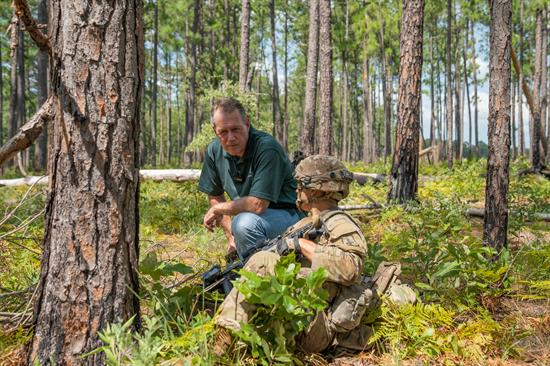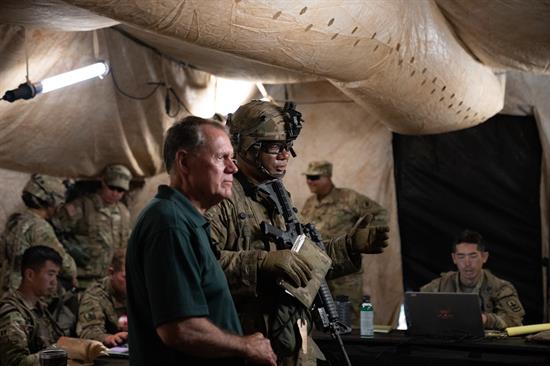(Washington, DC) -- U.S. Congressman Ed Case on Friday joined the Hawai‘i Army National Guard’s lead 29th Infantry Brigade Combat Team (29th IBCT) in the middle of a month-long advanced combat training exercise at the U.S. Army’s Joint Readiness Training Center (JRTC) in Fort Johnson, Louisiana.
The 29th IBCT is the lead component in the exercise and incorporates Guard units from 24 states. It is commanded by Colonel David Hatcher II of Honolulu and includes over 1,600 Guard members from throughout Hawai‘i.
Case, a member of the U.S. House Committee on Appropriations Subcommittee on Defense with oversight and funding responsibilities for all U.S. National Guard functions, was hosted by Brigadier General Steven Logan, Commander of the Hawai‘i Army National Guard, and Guard Command Sergeant Major James Jimenez.
The RTC at Fort Johnson (formerly Fort Polk) is one of the Army’s three premier combat training centers and provides the most advanced and realistic simulated combat conditions on a dedicated battlefield area larger than Moloka’i. Training participants including the 29th IBCT participate in a month-long full scale, multi-domain exercise against a highly trained real-life opposing force of active Army troops. It is the last major training exercise before participants are assessed as ready for actual deployment into combat environments.
Only ten training exercises are conducted annually at JRTC, of which usually only two are allocated to Guard units. About a third of Guards receive this advanced training. The 29th IBCT was awarded this coveted training slot over three years and has been progressing through levels of training to the capstone JRTC mission.
“As I visited, our troops had literally been in the field already – no beds, showers, regular meals, contact – for over a week in 24/7 operations in sweltering Louisiana summer heat and humidity and heavy uniforms and gear,” said Case. “They were executing very difficult maneuvers requiring high levels of expertise, coordination and flexibility in facing multiple threats from the opposing force on land, in the air, cyber, electromagnetic, counterintelligence and other forms, just as happens in the real world today.”
“Their trainers, who plan and watch every move and recognize accomplishments and offer constructive criticism, were very complimentary at their abilities and progress. They especially recognized the 29th’s internal cohesion, ability to work in very difficult conditions with their colleagues from elsewhere in the country, and readiness to listen to guidance and adjust.”
“I was honored to be able to join the Lava Brigade in this very realistic action as it was occurring and to talk with many for a little bit and relay how proud we are of them.”
The 29th Infantry Brigade Combat Team was formed in 1959, is headquartered at Kalaeloa, O’ahu with units on Hawai‘i Island, Maui, Moloka’i, O’ahu and Kaua’i as well as Arizona and California, and is the largest component of the Hawai‘i Army National Guard with over 3,000 troops. Over the course of his service in Congress, Case has visited the Hawai‘i Army Guard on deployment in Iraq, Afghanistan, Kosovo and Egypt/Sinai, and Washington, D.C. in the wake of January 6, 2001.
ATTACHMENTS: Pictures courtesy of Congressman Ed Case
###


